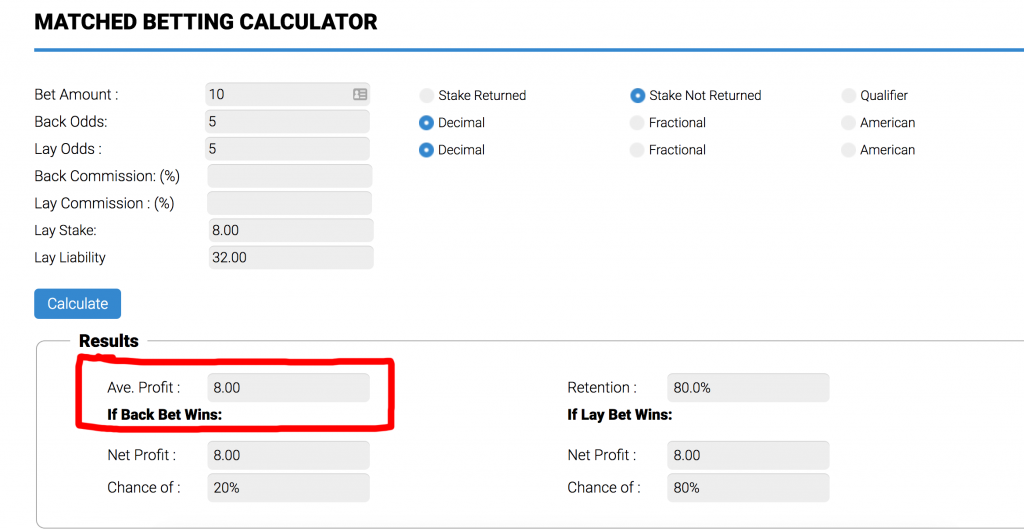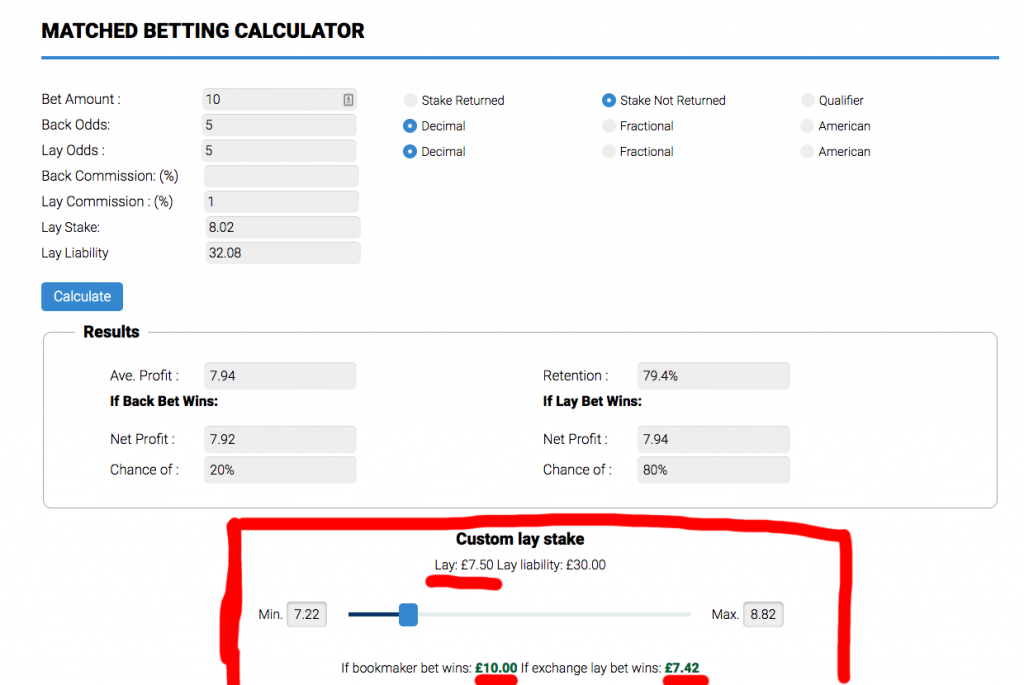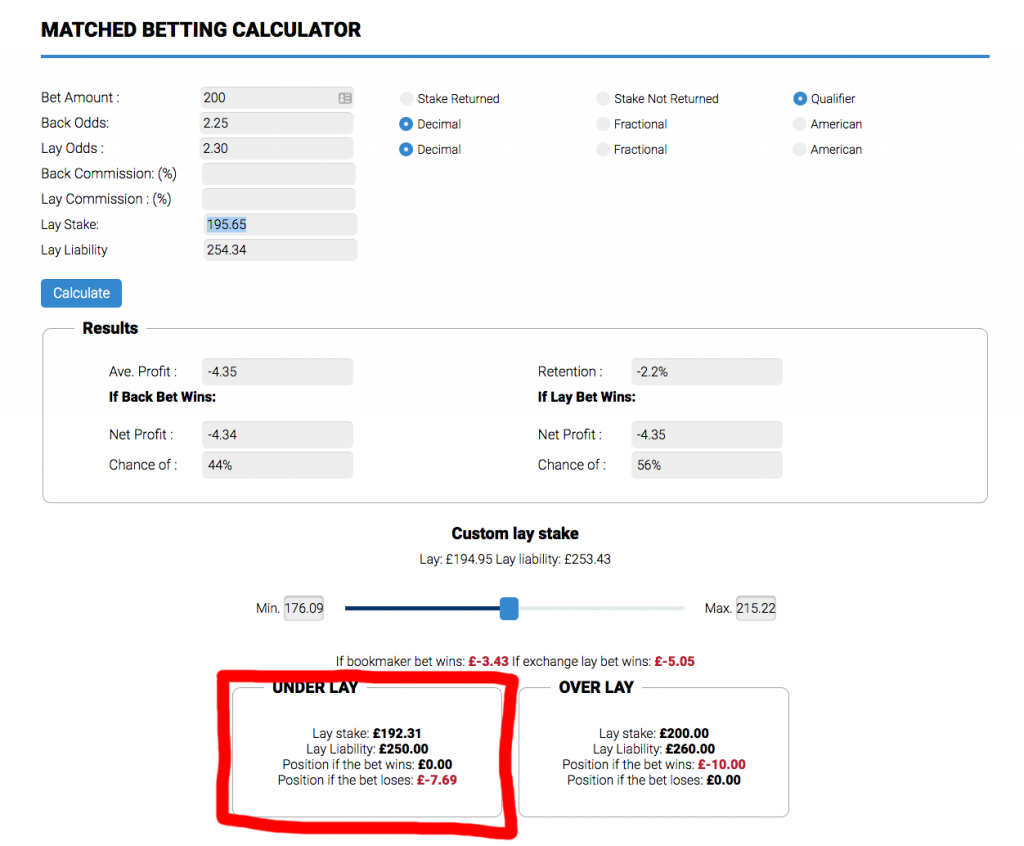Increase your profits with underlaying & overlaying
The word underlaying is something that you might see from time to time. It isn’t part of the basic matched betting approach. However, it can be useful on some occasions. If you have been confused by it then now is the time to clear things up.
Let’s take a look at what this is all about. It isn’t something that you will use all the time. But it is definitely worth knowing about.
The Basic Explanation
This is a technique that is used in matched betting. It has the same sort of starting point as with any other type of matched betting. Therefore, it involves a lay bet with an exchange and a back bet with a bookie. You still need to place each of these bets as you normally would.
What differs here is that the amounts vary from what you would normally use. Underlaying simply means placing a smaller lay stake. So, you are still putting on a bet with a bookie. You also still going to place a back bet with a betting exchange.
The only difference is in the size of these stakes. Normally, you would be looking for the best possible outcome in all cases. This means calculating both stakes carefully to try and win similar amounts no matter what happens. There is normally no real advantage in favouring one side of the bet.
Here is a standard example when using a £10 free bet. It locks in a profit of £8 regardless of the bet winning or losing.

With most matched betting, the overall position doesn’t change much either way. Whichever bet wins, you usually get a similar profit. You want to make sure that you have as much chance as possible of winning something. Since you don’t know what will happen, you cover all of the bases equally.
With underlaying we are skewing things slightly. We can calculate the lay bet with the exchange so that it is smaller. Why is this and what does it do?
Well, the most obvious effect is that the amount you win with the bookmaker varies. It is no longer giving an equal profit to the exchange bet. You now have a bigger payout potential on one of them.
Laying less money means that you win more from the bookmarker bet if it wins. On the other hand, you win less if the lay bet on the exchange comes up trumps.
Here is an example. I’ve used the same figures as above however I’ve used the custom lay stake feature on the calculator. Instead of laying £8, I’ve layed £7.50. This gives a £10 profit if the bet wins with the bookmaker or a £7.42 profit if the lay bet wins with the Exchange.

Why would you want to do something like that? There is a specific situation in which this is a good idea.
When should you use Underlaying?
There is a simple way to sum up when you could use this technique. It is when you are offered a bonus instantly with rollover requirements.
This is a way of helping you to complete the rollover requirements. You run less risk of losing too much of the bonus money whilst completing the wagering requirements. By skewing the overall bet like this, you can hope to walk away with more of the bonus.
In other types of matched betting it doesn’t add much value. Simply use it when you want to claim a bonus with rollover requirements.
Can Anyone Do It?
In theory, anyone can carry out underlaying. It isn’t particularly difficult to do, after all. You don’t need any special skills. Just what you learn here is enough to get you started. However, if you are new to matched betting you might be unsure about it.
This method of matched betting involves a little bit of extra work. If you are just starting on matched betting you might leave it for later. You don’t want to confuse yourself by trying it too early. Yet, there is no reason to be afraid of this technique.
That’s because the process is easy enough. You can see for yourself in the underlaying example a little bit further down. So, it is just a question of seeing if you are comfortable with it.
If you want to try it, just follow the steps noted below. It is a great feeling to try out a new technique like this successfully. More importantly, it will add another string to your bow for the future.
An Example
As always, an example can help to make this a lot clearer. Let’s look at a real life example that I have worked through. It will show you every step of the way.
I got a bonus offer from a bookmaker site a while ago. It said that I needed to deposit £100 to earn a bonus. This would earn an instant £100 bonus to my account. It was a nice deal but how much of the bonus could I keep?
Well, there was a 3x rollover requirement in place.
Naturally, I wanted to keep as much of the bonus intact as possible. Therefore, I decided to use underlaying to help me to do this. Let’s take a look at how I got on.
The first step was to claim the bonus. Remember that these offers are sometimes strictly time-limited. Once you have decided to do this, you need to look for suitable bets to use the bonus cash on.
In this example, I placed both the £100 deposit and the £100 bonus on the same outcome. So, my £200 was bet with the bookies at odds of 2.25.
The lay bet was then laid on the Smarkets site (0% commission). The odds in the exchange in this case were 2.30. £192.31 was the stake that I used for the lay bet. How did I work out this number? To do it, I went to the Bonus Bagging calculator. This is a useful tool that lets you easily work out accurate figures for underlaying.
Normally, the lay bet for this case would be £195.65. This would be to get the same result regardless of the outcome. It would give a loss of £4.35. This would usually be exactly how matched betting works. You tend to look for similar outcomes when you can. Although, they would normally both be profits rather than losses.
However, this website has a custom match function. You can use it to calculate the numbers with different lay bets. This lets you see right away how a change affects the overall position.
Doing this let me reduce the overall loss to 0 if the back bet won. If the bet lost then the overall result would be a loss of £7.69 You can see how I have titled the balance in one direction. This suited me in this case. I was looking to work through the rollover speedily without much loss.
 The benefit here is if the lay bet wins, you’ve lost all of your funds and have no more wagering requirements to complete – you are finished with the deal. If the back bet wins, you’ve not lost any money from the bonus which helps you complete the wagering requirements with some profit.
The benefit here is if the lay bet wins, you’ve lost all of your funds and have no more wagering requirements to complete – you are finished with the deal. If the back bet wins, you’ve not lost any money from the bonus which helps you complete the wagering requirements with some profit.
What Is Overlaying?
Have you seen the word overlaying used too? This is another technique that you might sometimes want to use. As the name suggests, it is the opposite of underlaying. When would you use overlaying?
This is a tactic that sees you make the lay bet bigger. This means that you stand to win more if the lay bet on the exchange wins. If the back bet is the winner then you win less.
It might not seem like a particularly useful approach. But it can be used in a certain type of situation. Overlaying can be a good move if you receive a bonus for winning the back bet. Certain types of promotion may offer you a deal like this.
This bonus makes up for not winning so much money on the bet itself. Alternatively, if the lay bet wins, you get a higher than normal return on it.
I’m not a big fan of overlaying and don’t use it.
Who Might Underlaying Suit?
This isn’t a strategy for beginners to matched betting. In fact, some people never really feel the need to use it all. You can carry on matched betting for years without worrying about this issue.
It is really down to each person to decide whether to give it a try. Having said that, it is only recommended for advanced, experienced users. You really need to be completely comfortable with the strategies needed.
If this is the case, you can get some extra success in this way. Holding on to more of the bonuses you receive is a great incentive for giving it a try. If you aren’t yet ready for it just stick to traditional matched betting until you are ready.
Underlaying & Overlaying Conclusion
This is a clever way of making the most of your bonus offers. It is a good technique to be aware of. At times it could be a great way of earning more money with less risk.
Yet, it is something that you probably won’t use very often. Therefore, the secret is in understanding when to use underlaying. If you choose the right situations and the right stakes it can be extremely useful.

